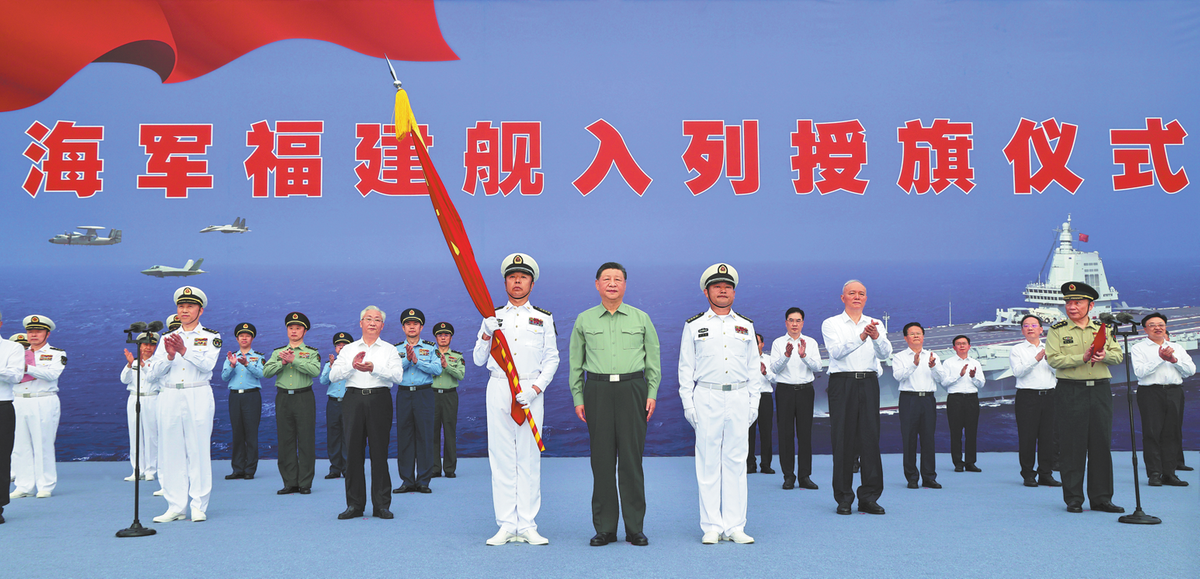Xi attends carrier's commissioning
CNS Fujian enters service as first in fleet with electromagnetic catapults


The People's Liberation Army Navy commissioned the CNS Fujian aircraft carrier on Wednesday, with President Xi Jinping conferring the PLA flag to its commanders and boarding to inspect China's first aircraft carrier equipped with electromagnetic catapults.
Xi, who is also general secretary of the Communist Party of China Central Committee and chairman of the Central Military Commission, took part in the commissioning ceremony of the supercarrier, named after the eastern coastal province of Fujian, at a naval base in Sanya, Hainan province. He personally handed a PLA flag to its captain and political commissar.
A total of 2,000 personnel from the Navy and defense contractors involved in the ship's design and construction project participated in the ceremony, which began at around 4:30 pm.
After the ceremony, Xi boarded and inspected the Fujian, which had several aircraft on its flight deck, including a J-35 stealth fighter jet and two KJ-600 early-warning and control planes. He listened to a report about China's carrier force and checked equipment on the flight deck.
The president then talked with pilots and deck crew of the Fujian, who presented him with a rehearsal of using an electromagnetic catapult to launch a fighter jet. It was Xi who made the final decision to install the electromagnetic catapult system, rather than conventional steam catapults.
He asked about the aircraft's capabilities and the characteristics of the electromagnetic catapult system and encouraged air operations support officers to keep honing their skills and combat capabilities.
The commander-in-chief also stepped inside the carrier's navigation and air-wing command bridges to inspect operations there. In the electromagnetic launch control station, Xi pressed the launch button, activating a catapult to accelerate its launching trolley.
He then visited a dining cabin and a sailors' living compartment to examine living standards on the vessel, and ordered units at all levels to improve their members' living and working conditions.
With a hull designation of 18, the Fujian displaces more than 80,000 metric tons of water, making it the largest and mightiest warship ever built outside the United States and one of the world's biggest naval vessels of all time.
The gigantic ship was designed by China State Shipbuilding Corp and was built at its Jiangnan Shipyard in Shanghai. It was officially unveiled in June 2022 and had undergone nine sea trials before delivery.
In September, the Navy announced that it had conducted successful electromagnetic launch and recovery tests of three types of aircraft — the J-35 and J-15T fighter jets and the KJ-600 — onboard the supercarrier. That meant the Fujian is now the world's first and only carrier to have used the electromagnetic catapult system to launch and recover a stealth aircraft.
Before the new carrier, the Navy operated two carriers — CNS Liaoning and CNS Shandong. Both have a standard displacement of around 50,000 tons and a conventional propulsion system, and use a ski jump mode for launching fixed-wing aircraft.
Song Zhongping, a retired PLA Rocket Force officer and now a military affairs commentator, said that China has extensive development and overseas interests. Having three carrier strike groups will greatly enhance its ability to safeguard national interests.
Song emphasized that China does not seek to engage in an arms race of aircraft carriers with any country. The commentator stated that to obtain a strong combat capability, the Fujian still needs continuous training and exercises after being commissioned into active service.
"Entering service is just a starting point, and the real-world tests will follow. I expect to see the Fujian show its real capabilities through coming deployments," Song noted.
Cao Weidong, a retired senior researcher at the PLA Naval Research Academy, said that compared with its two predecessors, the Fujian is much bigger and heavier, and has a larger flight deck and a smaller superstructure. These differences mean that it is able to carry more aircraft and fuel, and will be capable of deploying and recovering more fighter jets in a combat operation. The increased carrying capacity also means that the ship can sail further, operate longer and has stronger fighting power, he said.
Wang Yanan, chief editor of Aerospace Knowledge magazine, said that the electromagnetic catapult can launch fully fueled, fully armed fighter jets and large planes such as the KJ-600. In comparison, the ski-jump ramp has many restrictions on aircraft weight, meaning that combat jets can only bring certain amounts of fuel and weapons, limiting their combat capability and the carrier's launch efficiency.
zhaolei@chinadaily.com.cn
- Xi urges deepening reform, opening-up during Guangdong inspection tour
- Xi attends carrier's commissioning
- Senior Xi'an official facing probe by China's anti-corruption watchdogs
- Philippines risks creating trouble for itself: China's defense ministry
- Newborn with congenital heart disease receives life-saving surgery in Yunnan
- Hong Kong charity signs diplomatic talent deal with Beijing university




































